How To Care For Peperomia Plants (Best Guide)
Learn how to care for peperomia plants in this easy to follow, detailed guide!
Imagine walking through a lush jungle with thousands of vibrant green plants layered in a peaceful canopy of color. Your eye rests on the small, heart shaped leaves of the charming and popular peperomia plant.
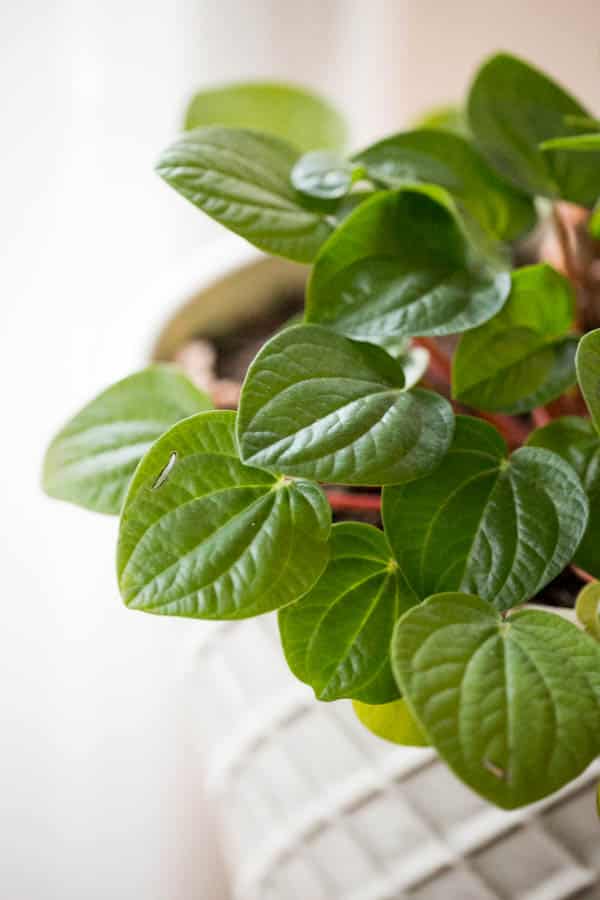
This heat loving plant cascades from the crevice of two rocks, unfurling with charm and beauty.
While you may not be able to travel to a tropical jungle to enjoy peperomia, you can easily grow and care for this gorgeous thick leaved plant in your own home.
Get our list of the most aesthetic house plants here!
About
With glossy green leaves and a succulent like drought tolerance, peperomia plants are a favorite for indoor gardeners.
Originating from the warm regions of South and Central America, the peperomia genus boast over 1,000 species. They are commonly known as radiator plants or a baby rubber plant and can feature stunning emerald heart-shaped leaves.
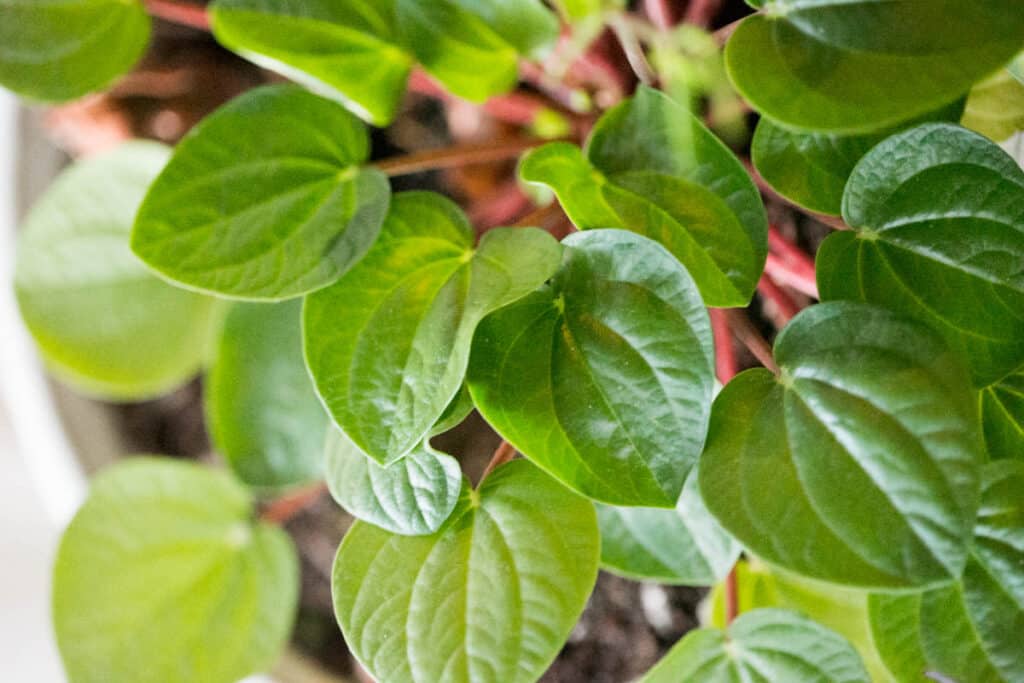
If you are looking for an easy to grow small houseplant with lots of character and vibrancy, peperomia may just be it!
These lush and vibrant indoor plants with waxy leaves are low maintenance and easy to grow. With their fleshy leaves and slow growing habit, they are popular indoor houseplants.
They fit into the tiny nooks that larger houseplants can’t squeeze into, and are incredibly easy for the novice gardener.
Peperomia are not unlike succulents: thriving off high humidity, moderate watering and bright indirect sunlight.
Let’s jump into peperomia plant care so you can keep your beautiful little rubber plant thriving!
Other Names: The Latin name for Peperomia plants is Peperomia obtusifolia. This charming plant also goes by the common name of pepper face, baby rubber plant, and American rubber plant.
Where Does Peperomia Come From?
We think the best way to learn about a plant is to do a deep dive into it’s native habitat. Understanding where your houseplant originally comes from is essential in caring for it’s needs!
The dark green leaves of peperomia primarily make their native appearance in warm, tropical areas in Central and South America. They are also found in Africa and Southern Asia.
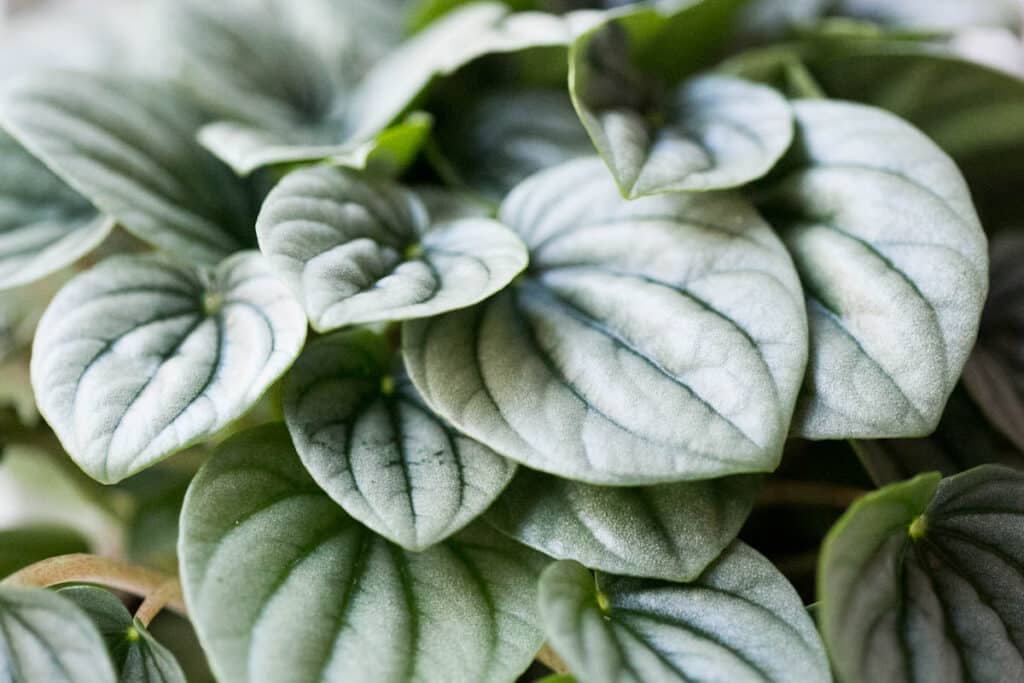
There are over 1,000 species of peperomia, with more varieties still being discovered and documented! The jungles provide a shaded canopy with lots of bright ambiant light, high moisture and rich, porous soil full of decaying matter.
Peperomia plants are a tropical plant that thrive in bright light. They have succulent like qualities and enjoy infrequent watering.
These highly adaptive plants come in many leaf shapes and are able to live in various habitats such as rock crevices, in sandy soils, or on other plants (the name for this is epiphytes, similar to Thanskgiving cacti).
Peperomia are compact, evergreen plants and many feature succulent like leaves that help the plant survive during drought.
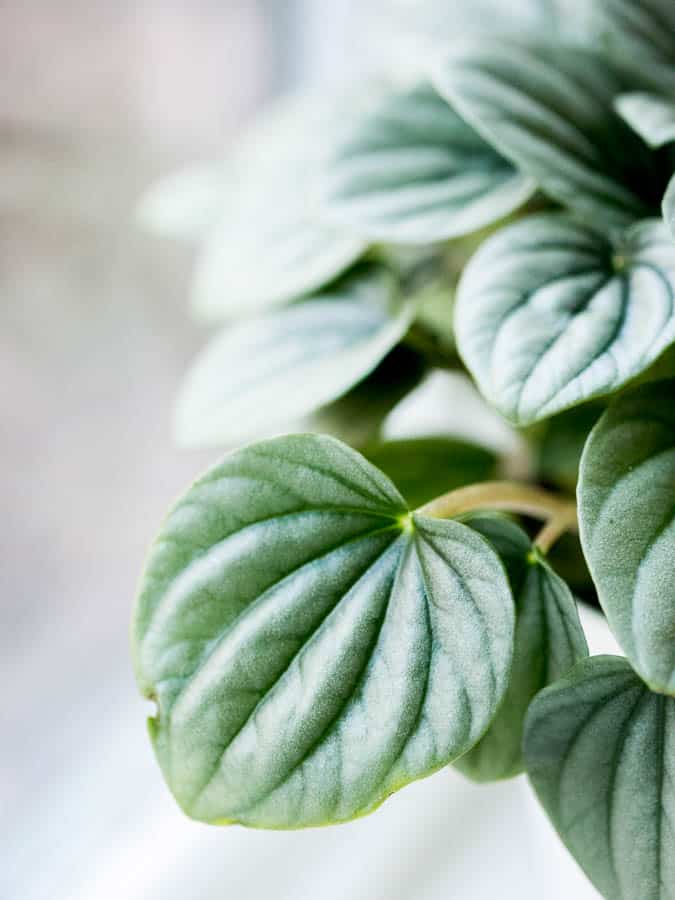
The species features many different leaf shapes: from spade to heart shape, diamond and oval. The color of the leaves varies as well: the plants can feature waxy dark green leaves, variegated silver and light green leaves, yellowish green, and even orange-red hues.
Peperomia are a diverse group of plants that add intrigue, beauty and calm to the indoor plant aesthetic.
Peperomia Care Guide
These vibrant green plants enjoy bright, indirect light, infrequent watering and loose, well draining soil or potting mix. This indoor plant is perfect for beginner houseplant enthusiasts, and we are here to share all the details of caring for this lovely, versatile houseplant.
Light For Peperomia Houseplants
Peperomia plants crave bright indirect light but can also tolerate low light conditions. Remember, this plants are found in tropical jungles, where both shade and beautiful ambient light abound!
In the wild, peperomia plants are used to adapting to a variety of conditions and they may be able to live in insufficient light in your home as well.
Plants with large leaves will need more light, where smaller leaf peperomia plants can tolerate lower light conditions. (Keep in mind that lower light may result in fewer leaves and a smaller plant).

But by and large these beautiful waxy green plants crave bright, diffused daily light. Think of a window with lots of ambiant light that floats through the air, as opposed to intense direct light.
In brighter light, you will see faster growth than you will in lower light conditions, more vibrant colors, and heartier leaves. Avoid placing your peperomia in direct bright sunlight, such as direct window light, or the leaves will surely burn.
If placed outside in the summer months, make sure your beautiful peperomia friend is exposed to indirect light (think bright ambient light like in a jungle). A covered patio or sunroom works well.
That harsh, direct sunlight will most certainly burn the leaves of your peperonia plant, so whether indoors or out, choose diffused light.
When grown indoors (as most commonly done), it is a good idea to regularly turn your peperomia plant towards the light source for even growing of the plant.
Peperomia can also grow under fluorescent lights. It can be helpful to add as an artificial light source in winter, or have it be a supplement light if the indoor location has little light.
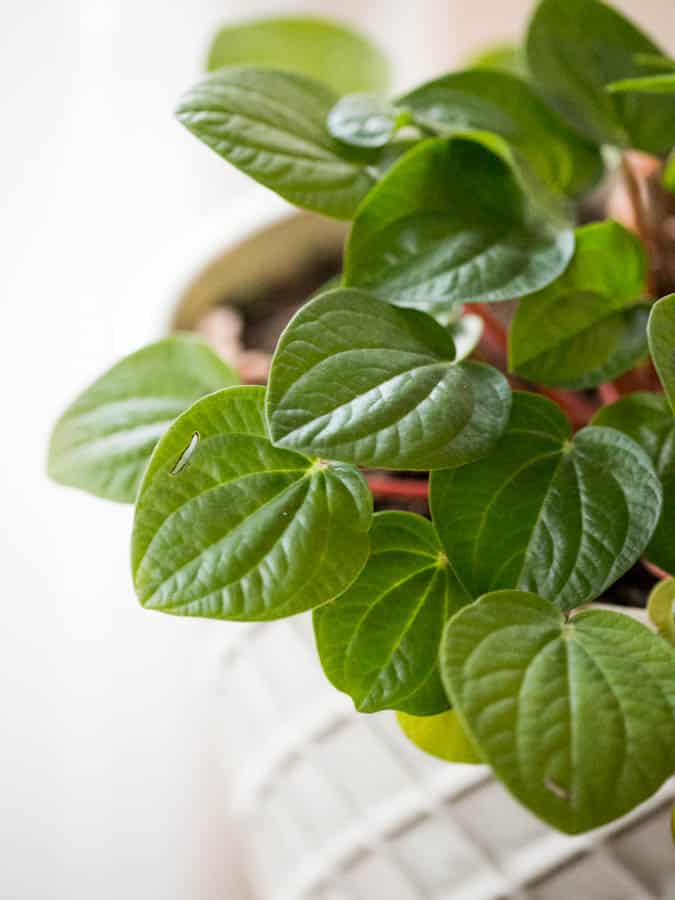
Water
Always let the soil of a peperomia plant dry out between watering. These succulent like plants are very susceptible to root rot, which will decay the roots and eventually kill the plant.
A drainage hole at the bottom of the container will greatly reduce the chance of root rot!
The thick, fleshy leaves of the peperomia plant contribute to their ability to store water for long periods of time.
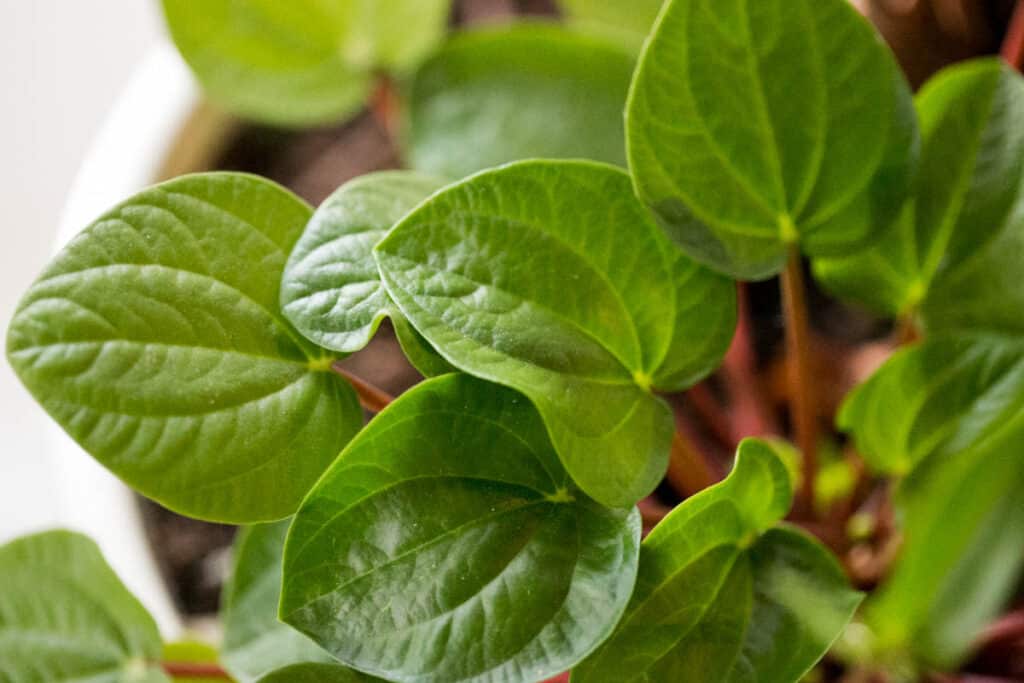
Due to how they grow in the wild, native species of peperomia often do not have direct access to ground water. They have shallow root systems and are drought tolerant, which contributes to their easy care when it comes to watering in the home environment.
Like most house plants, peperomia are particular when it comes to watering. Humidity level, room temperatures, soil type, light and container size can all effect the plant’s thirst and water needs.
A good way to check the plant’s moisture needs is to inspect the leaves. The thick leaves of the plant should be firm, and at the same time the soil will still be moist.
When the plant leaves start to wilt and loose their firmness, you know it is time to water. The soil will be dry or nearly dry at this time as well.
In late autumn and winter the air is drier, so expect to see your plant’s water needs increase.
During spring and summer there is more moisture in the air, and you may feel like you have gone a long time in between watering. Just keep checking the soil and leaf firmness and let your plant tell you when it’s thirsty!
Best Peperomia Watering Tips For Beginners:
- Err on the side of underwatering, not over watering! Watch the leaves of your plant for watering clues. If they are robust and firm, the plant needs plenty of water.
- When it’s time to water, water gently at the base of the plant and soak until water leaks out of the bottom of the container. Remove excess water from the drainage tray and let your tropical plants enjoy their soak.
Learn how to water snake plants here!
The Best Type Of Water For Peperomia Plants
The best water source for peperomia plants is rain water, because it is full of natural minerals but lacks many of the toxic chemicals found in tap water.
You can also purchase spring water that has nutrients in it that will nourish your peperomia plants.
You can easily collect rain water for your indoor plants using a rain barrel.
Soil
When it comes to soil, remember that peperomia are epithytes: they often grow off of other plants in the wild.
In their native habitat, peperomia tend to grow in mossy areas, on top of bark, and in loose soils.
Because of this, peperomia plants need loose, well draining soil. Orchid bark is an excellent addition for their soil as it is similar to their native growing conditions and encourages good drainage with moisture retention. An even mix of perlite and peat moss is a common growing mixture for peperomia.
Heavy soils will encourage root rot and disease.
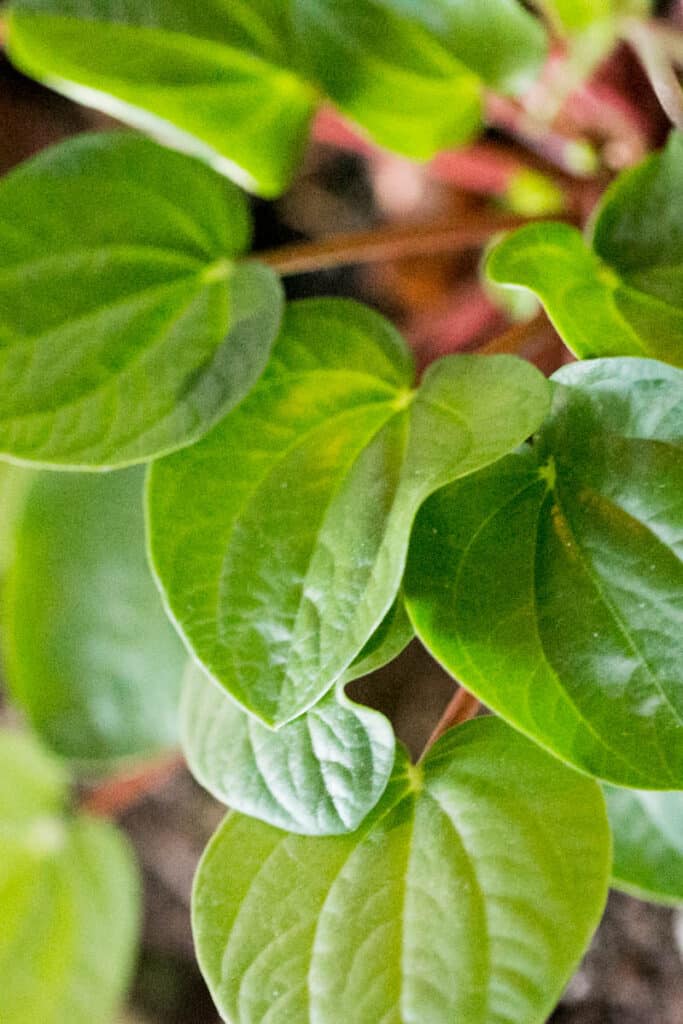
Humidity
Peperomia enjoy moderate humidity, about 40-50%. These plants will not thrive in a low humidity environment.
In their native habitat, Peperomia often live in cloud forests where the air stays heavy with warm moisture. That being said, peperomia love warm, moisture laden air and despise cold drafts.
Peperomia grown in bathrooms often thrive because of the high humidity created from frequent running water. (A bathroom featuring a high west-facing window would be an ideal location for growing a baby rubber plant!).
Since cold air holds less moisture than warm air, humidity will often drop in winter.
How To Increase Humidity For Your Peperomia Plant
The easiest way to increase humidity for your peperomia plant is to mist the plant. Use the same rain or spring water that you use to water with. Choose a fine misting water bottle like this one.
You can also a humidifier to add moisture into the air. This can be especially helpful during the drier winter months, when there is less water in the air.
Another good option for increasing humidity is to place a pebble tray beneath the plant.
Simply fill a dish with small pebbles and cover with water, then set your plant on top of this pebble tray. The water will act as the plant’s own personal humidifier.
You can also use a humidifier to add humidity to the air.
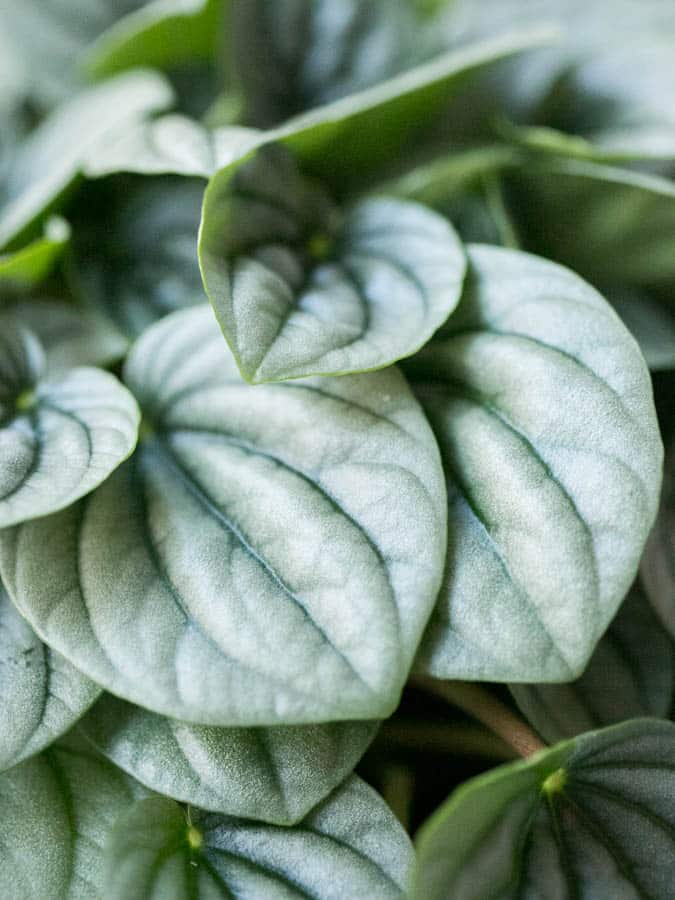
Ideal Room Temperature
Peperomia enjoy warm temperatures, ideally between 65 and 75 degrees.
The plant will not tolerate temperatures lower than 50 degrees, so be sure to watch the thermostat during the winter, especially when you are not home.
Keep the plant out of cold, drafty areas. Do not place a peperomia plant next to a cold, drafty door or window during winter!
Keeping temperatures warm and consistent will allow your peperomia plant to thrive.
Fertilizer
As long as their water and soil needs are met, fertilizer is very rarely needed for peperomia plants. These plants are not heavy feeders, so if you do decide to fertilizer, do so thoughtfully!
Over fertilizing can cause yellow leaves and leaf drop.
If you do decide to fertilize, the best time to do so is in the spring and summer when the plant is actively growing and producing new leaves. Use a liquid fertilizer and apply at the soil line (near the roots) to prevent the foliage from burning. A good recommended strength would be a low NPK ratio of 3-1-2.
This is a balance gentle fertilizer specific to indoor houseplants.

Propagation
Like many indoor plants, peperomia can be easily propagated through leaf cuttings.
The best time to propagate is in the early spring and summer when the plant is in it’s growing season. Choose healthy, strong leaves for your propagation efforts.
To protect the health of the mother plant, do not take more than 1/3 of the plant in stem cuttings. Pot your cuttings quickly and be sure to add rooting powder: this will speed up plant growth!
Stick the end of your leaf cutting directly into potting soil, making sure it is standing straight up. The leaf node is at the bottom of the plant and this is where you will find new growth sprouting!
Using a plastic bag, create a dome around your plant to trap in humidity.
Be patient, it can take several weeks to see growth on your baby plants, and up to a month to get roots established!
Soon you will have new plants to share and enjoy.
Learn how to grow spider plants from babies here!
Popular Varieties Of Peperomia
There are over a thousand peperomia varieties! These are a few of the most beloved for indoor plants:
Watermelon Peperomia (Peperomia Argyreia)
With aesthetically pleasing dark green leaves and white strip,es the watermelon peperomia is a favorite.
As it’s name implies, this peperomia variety is luscious and irresistable. Watermelo peperomia is a grower and only gets about 8 to 12 inches tall.
Feature it in small spaces such as bookshelves, kitchen counters and bedroom side tables. (Don’t forget you need indirect light!).
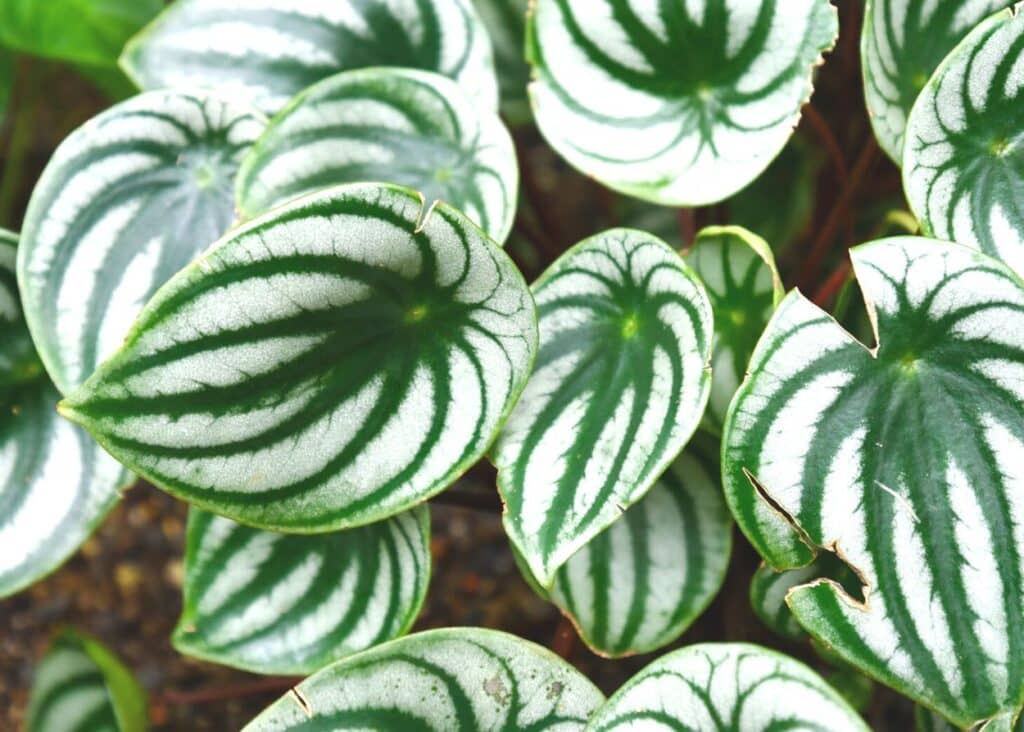
Peperomia caperata
With their unique heart shaped ridged leaves and rich colors caperata are another popular variety of peperomia.
Also known as emerald ripple peperomia (or silver ripple), this variety comes in many beautiful shades: orange, burgundy, silvery frost green, and purple with green highlights!
The leaves are large and heart shaped and in the summer they produce long slender red stems. This variety is absolutely stunning and just as easy to care for as any peperomia plant.
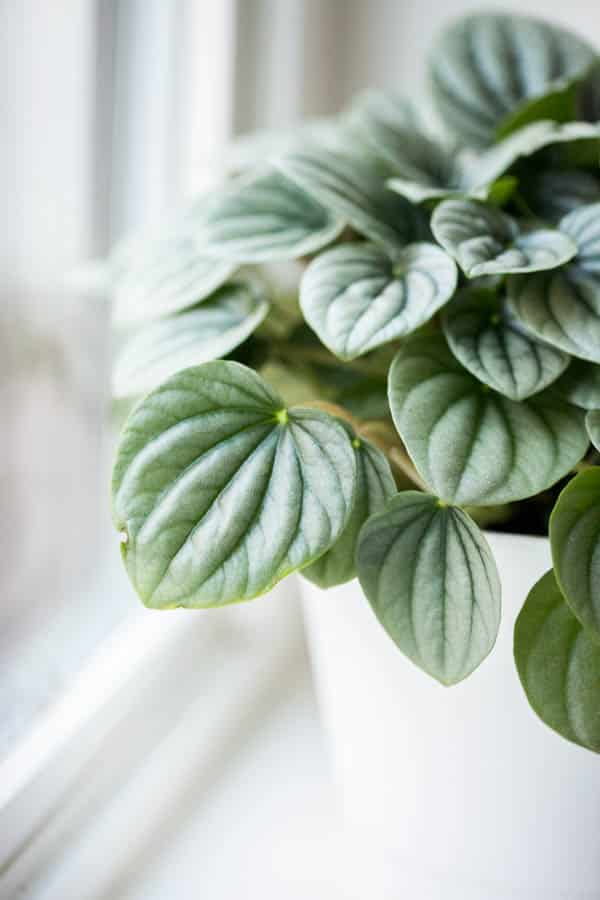
Peperomia prostrata (String of Turtles)
Whimsical and charming, String of Turtles (prostrata), are one of our favorite peperomia plants.
And who could resist them? These plants truly look like their namesake, “string of turtles.” Long strings of tiny oval shaped green leaves cascade from this small plant.
The leaves are variegated in light and dark green, truly making them look like tiny turtle shells (so adroable!).
If you are looking for a low maintenance plant that easily tucks into small places, String of Turtles is for you. Like all peperomia varieties, use well-draining, loose soil and choose bright ambient light.
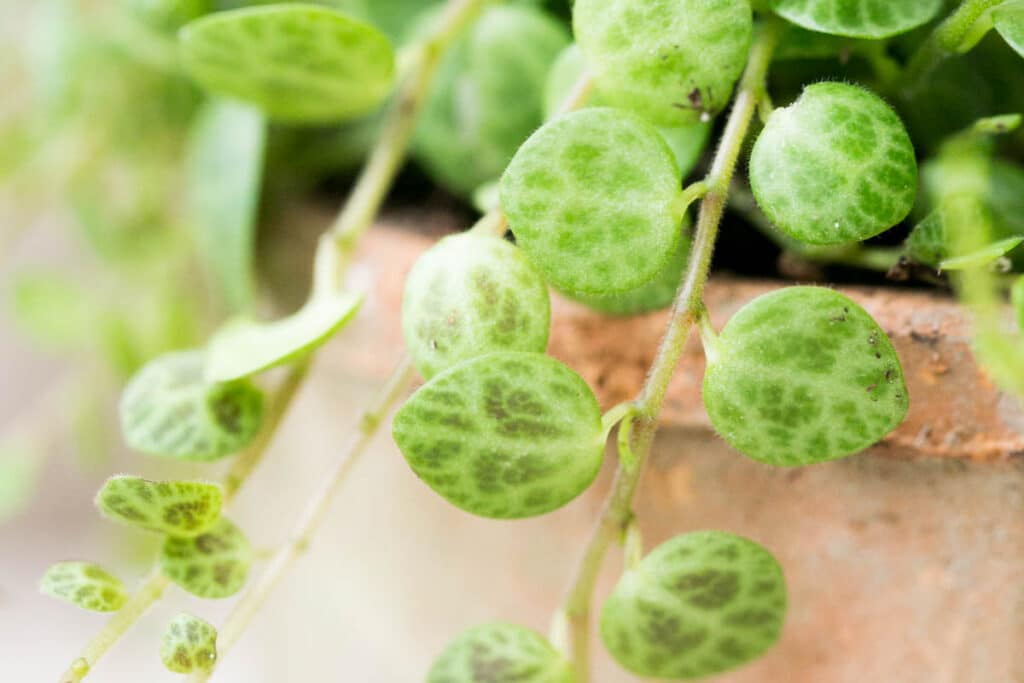
Common Problems
Fungal Disease
Fungal Disease is a common houseplant problem and often cause rot and decay in the roots of the plant. One of the main reasons we encourage healthy watering practices is to prevent disease in the peperomia plant.
The best way to prevent fungal plant diseases is to make sure you do not over water your plant, use a well draining potting soil, and make sure there is a drainage hole in the bottom of the pot.
(Yes, we may sound redundant, but these 3 tips are crucial for peperomia care and disease prevention!).
Also ensure that when watering you water near the base of the plant and do not let water pool on the leaves.

Indicators of fungal disease can be brown spots, curled or twisted leaves, and slowed growth. If you think your plant has a fungal disease, replace the potting soil with fresh soil and cut off diseased leaves.
If you suspect your plant has a serious viral or fungal infection, we recommend using this guide from the University of Florida to treat the disease.
At times plants do succumb to fungal diseases, and it can be best to start over with a new plant. Always use a new pot when doing so to prevent disease from spreading.
Pruning
Peperomia plants require very little work in the way of pruning.
As with most plants, you can pinch your peperomia back for bushier growth. To do this simply remove the plant foliage to the first set of leaves. This will encourage the plant to branch and create more stems at the point of pinching.
Maintenance pruning may involve occasionally removing damaged or sick leaves. That is all!
Causes Of Leaf Drop
The most common cause of peperomia leaf drop is over watering.
Remember, peperomia plants have succulent-like leaves and are able to store water in their leaves.
When over watering, the leaves will turn yellow and begin to drop off. Wait until the soil is almost completely dry or all the way dry, then soak deeply.
Conversely, if you neglect watering your peperomia completely, she may eventually dry out and her leaves will start falling.
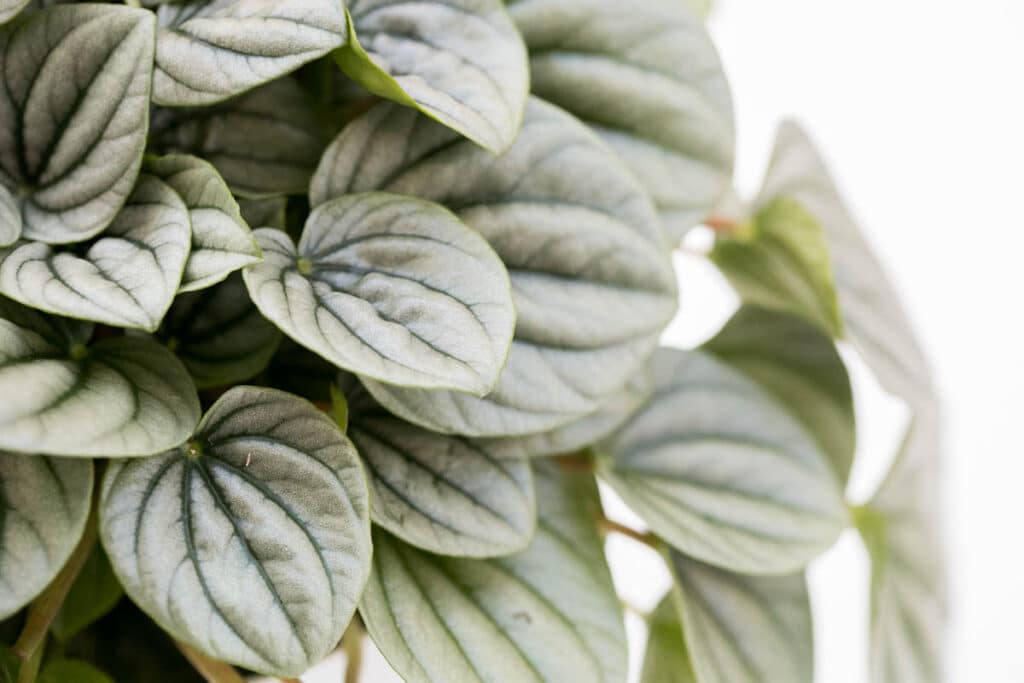
Pests
Some common pests that plague peperomia are fungus gnats, whiteflies, and spider mites.
Fungus gnats
Fungus gnats are small insects that harbor and infest in the potting mix of houseplants. These nasty creatures can become a problem because they chew the roots of the plant.
Their larvae can be particularly damaging to young plants as they feast on the plant’s roots.
The best way to avoid fungus gnats is to be preventative: let the soil of your peperomia plant dry out between watering!
Purchase a quality growing mix to start your plant in, and avoid any actively decaying organic matter, which can harbor more gnats. (Read more about fungus gnats here).
You can also get rid of the gnats by spraying a 4:1 solution of water to hydrogen peroxide on the gnats.
Spider Mites
Spider mites are tiny bugs that hang out on the underside of peperommia leaves. They can cause holes and discoloration in the leaves.
Spider mites are attracted to a dry environment, so the best way to prevent them is to keep the climate humid!
The first step in ridding your plant of spider mites is to gently bathe the plant (a shower works great for this), and remove the mites.
Spray with an insecticidal soap first, then add neem oil. Neem oil is a natural pest repellent that will repel spider mites.
White Flies
Whiteflies are tiny insects that pierce and eat indoor plants. Wash off the bugs and then follow up by spraying the leaves of your plant with insecticidal soap.
FAQS
Hailing from tropical areas, Peperomia are heat loving plants and will not tolerate temperatures lower than 50 degrees. Ideal temperatures for your peperomia plants are between 60 and 80 degrees. Peperomia cannot tolerate frost and need to be kept out of cool drafty air during the winter.
Yes, peperomia make an exellent indoor plant. They are a low maintenance indoor plant that make a cheerful, easy houseplant for first time owners. Peperomia are highly adaptable to different growing conditions, do not require frequent watering, and boast beautiful thick green leaves.
When given the right care, peperomia can live for an average of ten years. Keep in mind that with the wide variety of peperomia species, there may be a huge difference in life span between the species.
Yes, peperomia are wonderful air purifiers.
No, according to the ASPCA peperomia are non toxic and are not poisonous to dogs.
No, according to the ASPCA peperomia are non toxic and are not poisonous to cats.
To keep your peperomia plant happy, give her bright, indirect light and a humid environment. Make sure she has well draining soil and a drainage hole in the bottom of the container. Peperomia plants are very easy to grow, and the main culprit for disease is actaully paying too much attention to the little plant in the form of over watering!
Yes, a bathroom can be a perfect spot for a perperomia plant! The humidity from a shower will thrill your plant, and she can thrive even underneath fluorescent lighting. Make sure there is a light source every day.
Yes, you can grow perpomia outside, but you must have a warm environment for the plant to live in. Temperatures should remain above 50 degrees (even at night), and ideally stay between 65 and 85 degrees. Avoid placing an outdoor plant in direct sunlight or the tips of the plant will burn.

Conclusion
We hope you enjoyed our thorough guide on how to care for peperomia plants. These vibrant small indoor plants offer many benefits: they add a mini oasis of vibrant green, clean the air, and add character to your home.
Peperomia are easy to care for, require little care and are fun to grow!
Let us know in the comments how your peperomia plants are doing. Happy indoor gardening!

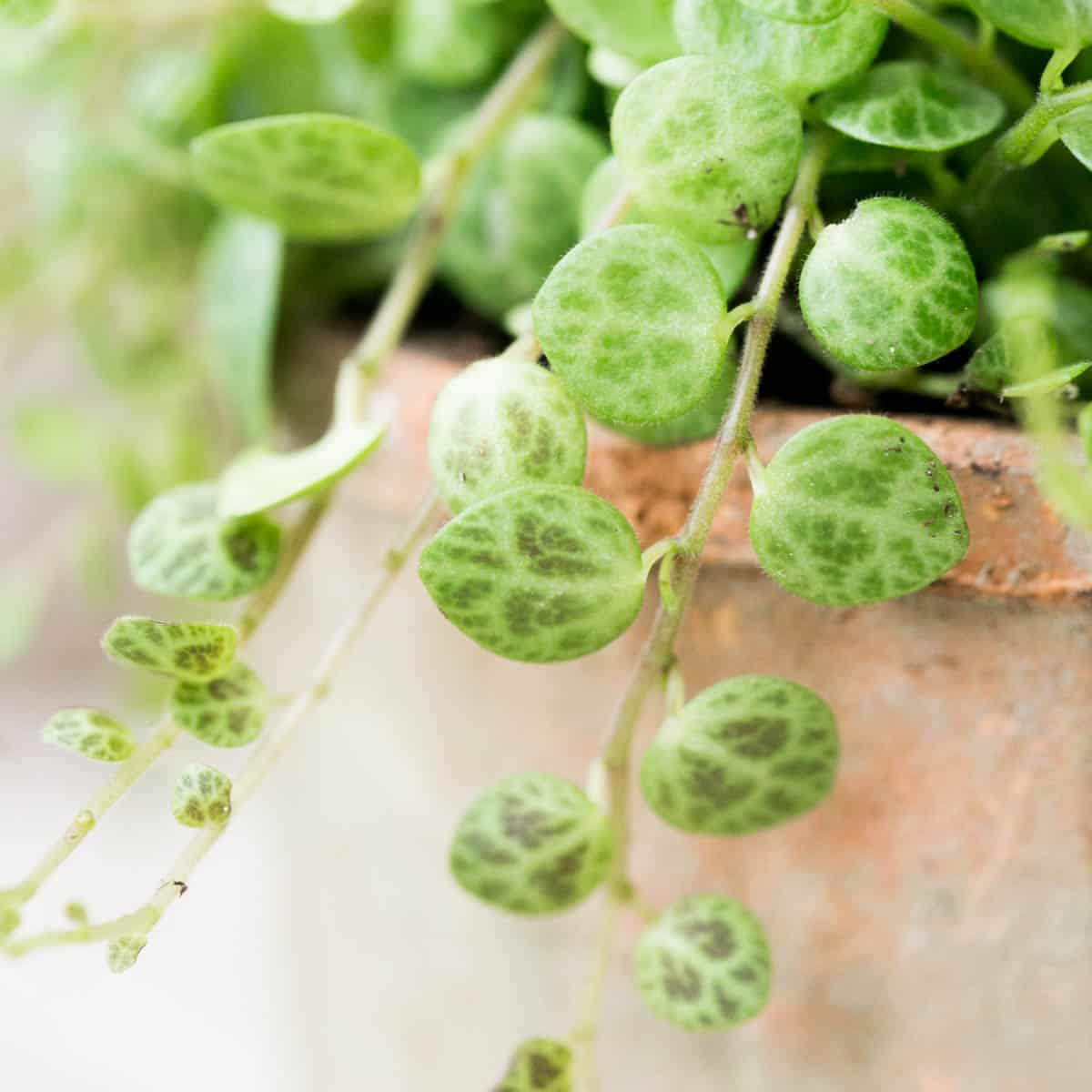

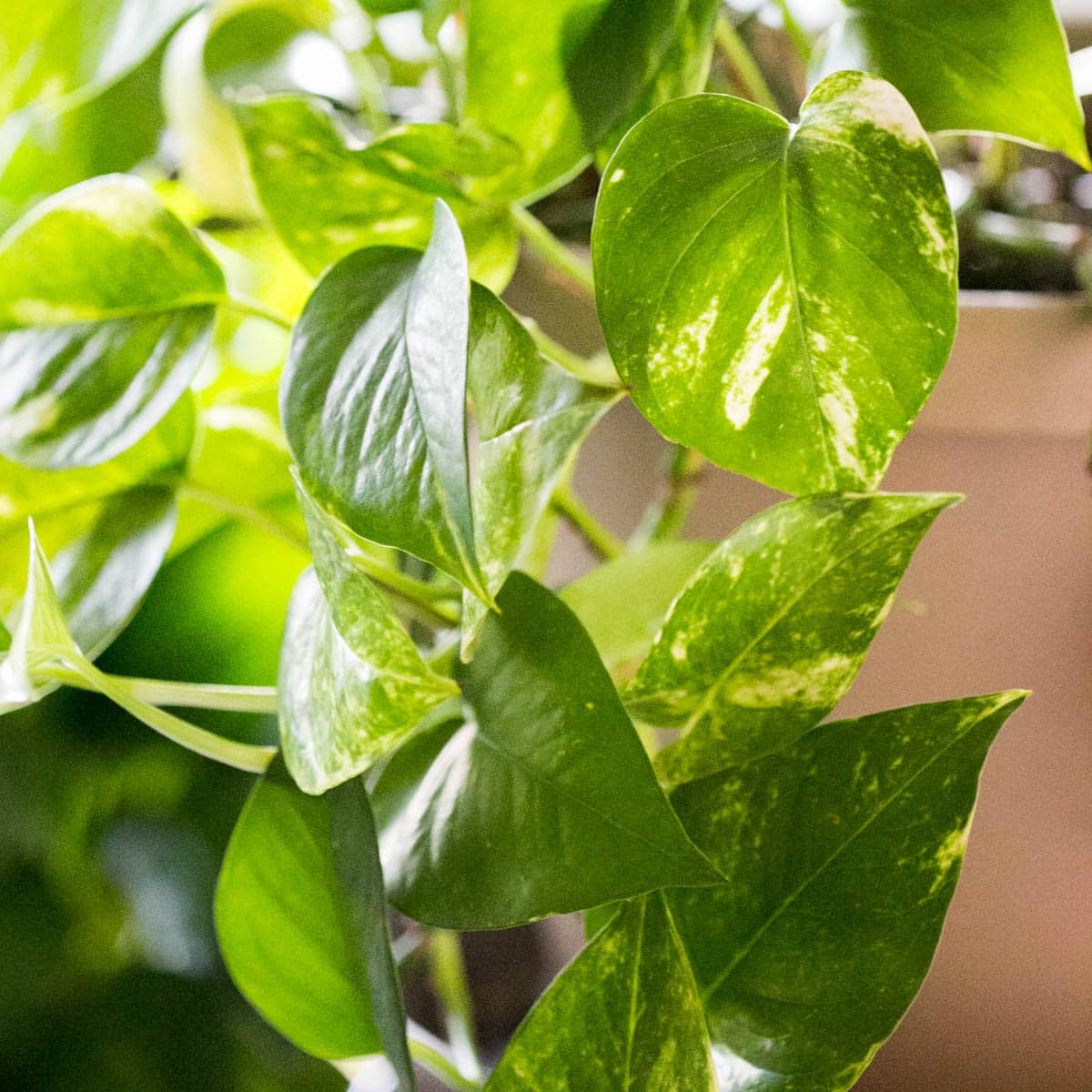
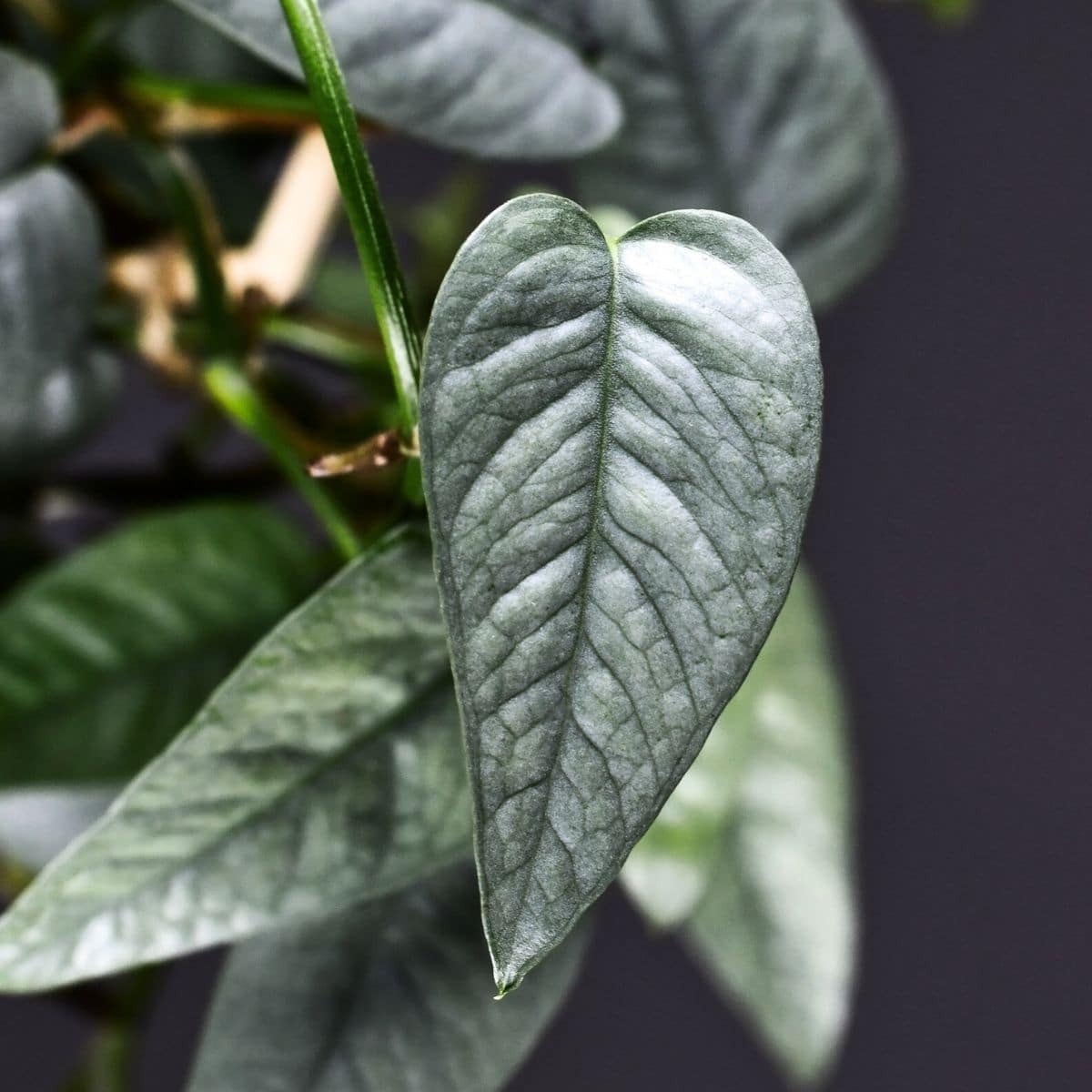

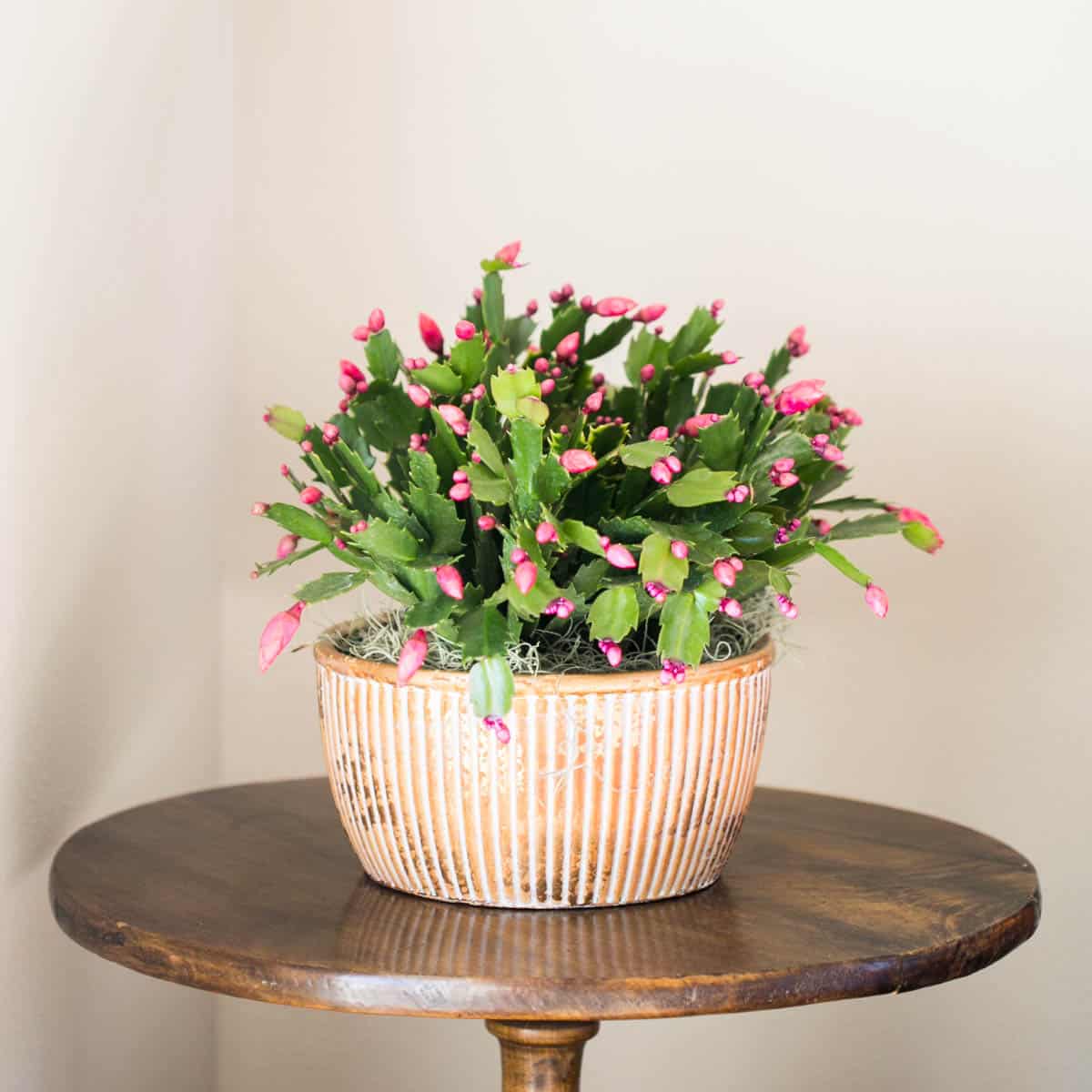
Hi!
Thanks so much for your info! Can you tell me what species of Pepperonia is in the first photo? It’s exactly the kind that I have,
Cheers!
Shauna O’Connor
Hi Shauna!
Thanks for stopping by! That specific peperomia plant belongs to my mom, I’m shooting her a message to see if she can ID it for us. I’ll keep you updated.